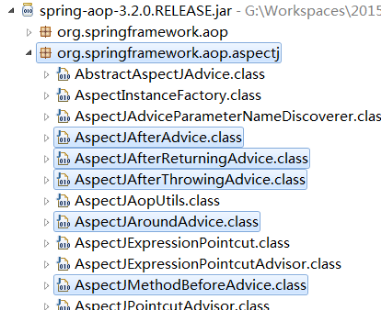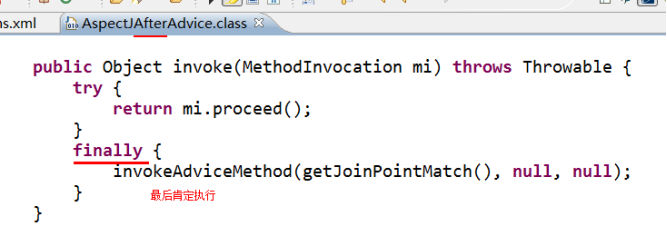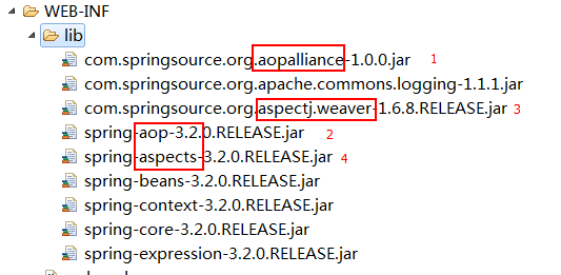9.3AspectJ
1.1 介绍
AspectJ是一个基于Java语言的AOP框架
Spring2.0以后新增了对AspectJ切点表达式支持
@AspectJ 是AspectJ1.5新增功能,通过JDK5注解技术,允许直接在Bean类中定义切面
新版本Spring框架,建议使用AspectJ方式来开发AOP
主要用途:自定义开发
切入点表达式【掌握】
1.execution() 用于描述方法 【掌握】
语法:execution(修饰符 返回值 包.类.方法名(参数) throws异常)
修饰符,一般省略
public 公共方法
* 任意
返回值,不能省略
void 返回没有值
String 返回值字符串
* 任意
包,[省略]
com.itheima.crm 固定包
com.itheima.crm.*.service crm包下面子包任意 (例如:com.itheima.crm.staff.service)
com.itheima.crm.. crm包下面的所有子包(含自己)
com.itheima.crm.*.service.. crm包下面任意子包,固定目录service,service目录任意包
类,[省略]
UserServiceImpl 指定类
*Impl 以Impl结尾
User* 以User开头
* 任意
方法名,不能省略
addUser 固定方法
add* 以add开头
*Do 以Do结尾
* 任意
(参数)
() 无参
(int) 一个整型
(int ,int) 两个
(..) 参数任意
throws ,可省略,一般不写。
综合1
execution(* com.itheima.crm.*.service..*.*(..))
综合2
<aop:pointcut expression="execution(* com.itheima.*WithCommit.*(..)) ||
execution(* com.itheima.*Service.*(..))" id="myPointCut"/>
2.within:匹配包或子包中的方法(了解)
within(com.itheima.aop..*)
3.this:匹配实现接口的代理对象中的方法(了解)
this(com.itheima.aop.user.UserDAO)
4.target:匹配实现接口的目标对象中的方法(了解)
target(com.itheima.aop.user.UserDAO)
5.args:匹配参数格式符合标准的方法(了解)
args(int,int)
6.bean(id) 对指定的bean所有的方法(了解)
bean('userServiceId')
1.3 AspectJ 通知类型
laop联盟定义通知类型,具有特性接口,必须实现,从而确定方法名称。
laspectj 通知类型,只定义类型名称。已经方法格式。
个数:6种,知道5种,掌握1中。
before:前置通知(应用:各种校验)
在方法执行前执行,如果通知抛出异常,阻止方法运行
afterReturning:后置通知(应用:常规数据处理)
方法正常返回后执行,如果方法中抛出异常,通知无法执行
必须在方法执行后才执行,所以可以获得方法的返回值。
around:环绕通知(应用:十分强大,可以做任何事情)
方法执行前后分别执行,可以阻止方法的执行
必须手动执行目标方法
afterThrowing:抛出异常通知(应用:包装异常信息)
方法抛出异常后执行,如果方法没有抛出异常,无法执行
after:最终通知(应用:清理现场)
方法执行完毕后执行,无论方法中是否出现异常
环绕
try{
//前置:before
//手动执行目标方法
//后置:afterRetruning
} catch(){
//抛出异常 afterThrowing
} finally{
//最终 after
}




1.1 导入jar包
l 4个:
aop联盟规范
spring aop 实现
aspect 规范
spring aspect 实现

一、 基于xml
1.目标类:接口 + 实现
2.切面类:编写多个通知,采用aspectj 通知名称任意(方法名任意)
3.aop编程,将通知应用到目标类
4.测试
切面类
MyAspect.java
package com.jd.proxy.aspect.xml; import org.aspectj.lang.JoinPoint;
import org.aspectj.lang.ProceedingJoinPoint; /**
* 切面类,含有多个通知
*/
public class MyAspect { public void myBefore(JoinPoint joinPoint){
System.out.println("前置通知 : " + joinPoint.getSignature().getName());
} public void myAfterReturning(JoinPoint joinPoint,Object ret){
System.out.println("后置通知 : " + joinPoint.getSignature().getName() + " , -->" + ret);
} public Object myAround(ProceedingJoinPoint joinPoint) throws Throwable{
System.out.println("前");
//手动执行目标方法
Object obj = joinPoint.proceed(); System.out.println("后");
return obj;
} public void myAfterThrowing(JoinPoint joinPoint,Throwable e){
System.out.println("抛出异常通知 : " + e.getMessage());
} public void myAfter(JoinPoint joinPoint){
System.out.println("最终通知");
} }
spring配置
beans.xml
<?xml version="1.0" encoding="UTF-8"?>
<beans xmlns="http://www.springframework.org/schema/beans"
xmlns:xsi="http://www.w3.org/2001/XMLSchema-instance"
xmlns:aop="http://www.springframework.org/schema/aop"
xsi:schemaLocation="http://www.springframework.org/schema/beans
http://www.springframework.org/schema/beans/spring-beans.xsd
http://www.springframework.org/schema/aop
http://www.springframework.org/schema/aop/spring-aop.xsd">
<!-- 创建目标类 -->
<bean id="userServiceId" class="com.jd.proxy.aspect.xml.UserServiceImpl"></bean>
<!-- 创建切面类(通知) -->
<bean id="myAspectId" class="com.jd.proxy.aspect.xml.MyAspect"></bean>
<!-- aop编程
<aop:aspect> 将切面类 声明“切面”,从而获得通知(方法)
ref 切面类引用
<aop:pointcut> 声明一个切入点,所有的通知都可以使用。
expression 切入点表达式
id 名称,用于其它通知引用
-->
<aop:config>
<aop:aspect ref="myAspectId">
<aop:pointcut expression="execution(* com.jd.proxy.aspect.xml.UserServiceImpl.*(..))" id="myPointCut"/> <!-- 3.1 前置通知
<aop:before method="" pointcut="" pointcut-ref=""/>
method : 通知,及方法名
pointcut :切入点表达式,此表达式只能当前通知使用。
pointcut-ref : 切入点引用,可以与其他通知共享切入点。
通知方法格式:public void myBefore(JoinPoint joinPoint){
参数1:org.aspectj.lang.JoinPoint 用于描述连接点(目标方法),获得目标方法名等
例如:
<aop:before method="myBefore" pointcut-ref="myPointCut"/>
--> <!-- .2后置通知 ,目标方法后执行,获得返回值
<aop:after-returning method="" pointcut-ref="" returning=""/>
returning 通知方法第二个参数的名称
通知方法格式:public void myAfterReturning(JoinPoint joinPoint,Object ret){
参数1:连接点描述
参数2:类型Object,参数名 returning="ret" 配置的
例如:
<aop:after-returning method="myAfterReturning" pointcut-ref="myPointCut" returning="ret" />
--> <!-- 3.3 环绕通知
<aop:around method="" pointcut-ref=""/>
通知方法格式:public Object myAround(ProceedingJoinPoint joinPoint) throws Throwable{
返回值类型:Object
方法名:任意
参数:org.aspectj.lang.ProceedingJoinPoint
抛出异常
执行目标方法:Object obj = joinPoint.proceed();
例如:
<aop:around method="myAround" pointcut-ref="myPointCut"/>
-->
<!-- 3.4 抛出异常
<aop:after-throwing method="" pointcut-ref="" throwing=""/>
throwing :通知方法的第二个参数名称
通知方法格式:public void myAfterThrowing(JoinPoint joinPoint,Throwable e){
参数1:连接点描述对象
参数2:获得异常信息,类型Throwable ,参数名由throwing="e" 配置
例如:
<aop:after-throwing method="myAfterThrowing" pointcut-ref="myPointCut" throwing="e"/>
-->
<!-- 3.5 最终通知 -->
<aop:after method="myAfter" pointcut-ref="myPointCut"/> </aop:aspect>
</aop:config>
</beans>
UserService.java
package com.jd.proxy.aspect.xml;
public interface UserService {
public void addUser();
public String updateUser();
public void deleteUser();
}
UserServiceImpl.java
package com.jd.proxy.aspect.xml;
public class UserServiceImpl implements UserService {
@Override
public void addUser() {
System.out.println("d_aspect.a_xml addUser");
}
@Override
public String updateUser() {
System.out.println("d_aspect.a_xml updateUser");
// int i = 1/ 0;
return "阳志就是屌";
}
@Override
public void deleteUser() {
System.out.println("d_aspect.a_xml deleteUser");
}
}
TestAspectXml.java
package com.jd.proxy.aspect.xml; import org.junit.Test;
import org.springframework.context.ApplicationContext;
import org.springframework.context.support.ClassPathXmlApplicationContext; public class TestAspectXml { @Test
public void demoAspect(){
String xmlPath = "com/jd/proxy/aspect/xml/beans.xml";
ApplicationContext applicationContext = new ClassPathXmlApplicationContext(xmlPath); //获得目标类
UserService userService = (UserService) applicationContext.getBean("userServiceId");
userService.addUser();
userService.updateUser();
userService.deleteUser();
} }
二、 基于注解
1.1.1 替换bean
<!-- 创建目标类 --> <bean id="userServiceId" class="com.itheima.d_aspect.b_anno.UserServiceImpl"></bean> <!-- 创建切面类(通知) --> <bean id="myAspectId" class="com.itheima.d_aspect.b_anno.MyAspect"></bean>
注意:扫描
<beans xmlns="http://www.springframework.org/schema/beans"
xmlns:xsi="http://www.w3.org/2001/XMLSchema-instance"
xmlns:context="http://www.springframework.org/schema/context"
xmlns:aop="http://www.springframework.org/schema/aop"
xsi:schemaLocation="http://www.springframework.org/schema/beans
http://www.springframework.org/schema/beans/spring-beans.xsd
http://www.springframework.org/schema/aop
http://www.springframework.org/schema/aop/spring-aop.xsd
http://www.springframework.org/schema/context
http://www.springframework.org/schema/context/spring-context.xsd">
<!-- .扫描 注解类 -->
<context:component-scan base-package="com.itheima.d_aspect.b_anno"></context:component-scan>
替换aop
必须进行aspectj 自动代理
<!-- .确定 aop注解生效 --> <aop:aspectj-autoproxy></aop:aspectj-autoproxy>
声明切面
<aop:aspect ref="myAspectId">
替换前置通知
<aop:before method="myBefore" pointcut="execution(* com.itheima.d_aspect.b_anno.UserServiceImpl.*(..))"/>
//切入点当前有效
@Before("execution(* com.itheima.d_aspect.b_anno.UserServiceImpl.*(..))")
public void myBefore(JoinPoint joinPoint){
System.out.println("前置通知 : " + joinPoint.getSignature().getName());
}
替换 公共切入点
<aop:pointcut expression="execution(* com.itheima.d_aspect.b_anno.UserServiceImpl.*(..))" id="myPointCut"/>
//声明公共切入点
@Pointcut("execution(* com.itheima.d_aspect.b_anno.UserServiceImpl.*(..))")
private void myPointCut(){
}
替换后置
<aop:after-returning method="myAfterReturning" pointcut-ref="myPointCut" returning="ret" />
@AfterReturning(value="myPointCut()" ,returning="ret")
public void myAfterReturning(JoinPoint joinPoint,Object ret){
System.out.println("后置通知 : " + joinPoint.getSignature().getName() + " , -->" + ret);
}
替换环绕
<aop:around method="myAround" pointcut-ref="myPointCut"/>
@Around(value = "myPointCut()")
public Object myAround(ProceedingJoinPoint joinPoint) throws Throwable{
System.out.println("前");
//手动执行目标方法
Object obj = joinPoint.proceed();
System.out.println("后");
return obj;
}
替换抛出异常
<aop:after-throwing method="myAfterThrowing" pointcut="execution(* com.itheima.d_aspect.b_anno.UserServiceImpl.*(..))" throwing="e"/>
@AfterThrowing(value="execution(* com.itheima.d_aspect.b_anno.UserServiceImpl.*(..))" ,throwing="e")
public void myAfterThrowing(JoinPoint joinPoint,Throwable e){
System.out.println("抛出异常通知 : " + e.getMessage());
}
整体代码
UserServiceImpl.java
package com.jd.proxy.aspect.anno;
import org.springframework.stereotype.Service;
@Service("userServiceId")
public class UserServiceImpl implements UserService {
@Override
public void addUser() {
System.out.println("d_aspect.b_anno addUser");
}
@Override
public String updateUser() {
System.out.println("d_aspect.b_anno updateUser");
int i = / ;
return "阳志就是屌";
}
@Override
public void deleteUser() {
System.out.println("d_aspect.b_anno deleteUser");
}
}
UserService.java
package com.jd.proxy.aspect.anno;
public interface UserService {
public void addUser();
public String updateUser();
public void deleteUser();
}
MyAspect.java
package com.jd.proxy.aspect.anno; import org.aspectj.lang.JoinPoint;
import org.aspectj.lang.ProceedingJoinPoint;
import org.aspectj.lang.annotation.After;
import org.aspectj.lang.annotation.AfterReturning;
import org.aspectj.lang.annotation.AfterThrowing;
import org.aspectj.lang.annotation.Around;
import org.aspectj.lang.annotation.Aspect;
import org.aspectj.lang.annotation.Before;
import org.aspectj.lang.annotation.Pointcut;
import org.springframework.stereotype.Component; /**
* 切面类,含有多个通知
*/
@Component
@Aspect
public class MyAspect { //切入点当前有效
// @Before("execution(* com.jd.proxy.aspect.anno.UserServiceImpl.*(..))")
public void myBefore(JoinPoint joinPoint){
System.out.println("前置通知 : " + joinPoint.getSignature().getName());
} //声明公共切入点
@Pointcut("execution(* com.jd.proxy.aspect.anno.UserServiceImpl.*(..))")
private void myPointCut(){
} // @AfterReturning(value="myPointCut()" ,returning="ret")
public void myAfterReturning(JoinPoint joinPoint,Object ret){
System.out.println("后置通知 : " + joinPoint.getSignature().getName() + " , -->" + ret);
} // @Around(value = "myPointCut()")
public Object myAround(ProceedingJoinPoint joinPoint) throws Throwable{
System.out.println("前");
//手动执行目标方法
Object obj = joinPoint.proceed(); System.out.println("后");
return obj;
} // @AfterThrowing(value="execution(* com.jd.proxy.aspect.anno.UserServiceImpl.*(..))" ,throwing="e")
public void myAfterThrowing(JoinPoint joinPoint,Throwable e){
System.out.println("抛出异常通知 : " + e.getMessage());
} @After("myPointCut()")
public void myAfter(JoinPoint joinPoint){
System.out.println("最终通知");
} }
beans.xml
<?xml version="1.0" encoding="UTF-8"?>
<beans xmlns="http://www.springframework.org/schema/beans"
xmlns:xsi="http://www.w3.org/2001/XMLSchema-instance"
xmlns:context="http://www.springframework.org/schema/context"
xmlns:aop="http://www.springframework.org/schema/aop"
xsi:schemaLocation="http://www.springframework.org/schema/beans
http://www.springframework.org/schema/beans/spring-beans.xsd
http://www.springframework.org/schema/aop
http://www.springframework.org/schema/aop/spring-aop.xsd
http://www.springframework.org/schema/context
http://www.springframework.org/schema/context/spring-context.xsd"> <!-- .扫描 注解类 -->
<context:component-scan base-package="com.jd.proxy.aspect.anno"></context:component-scan> <!-- .确定 aop注解生效 -->
<aop:aspectj-autoproxy></aop:aspectj-autoproxy> </beans>
TestAspectAnno.java
package com.jd.proxy.aspect.anno; import org.junit.Test;
import org.springframework.context.ApplicationContext;
import org.springframework.context.support.ClassPathXmlApplicationContext; public class TestAspectAnno { @Test
public void demoAnno(){
String xmlPath = "com/jd/proxy/aspect/anno/beans.xml";
ApplicationContext applicationContext = new ClassPathXmlApplicationContext(xmlPath); //获得目标类
UserService userService = (UserService) applicationContext.getBean("userServiceId");
userService.addUser();
userService.updateUser();
userService.deleteUser();
} }
JdbcTemplate
l spring 提供用于操作JDBC工具类,类似:DBUtils。
l 依赖 连接池DataSource (数据源)
1.1 环境搭建
1.1.1 创建表
create database ee19_spring_day02;
use ee19_spring_day02;
create table t_user(
id int primary key auto_increment,
username varchar(),
password varchar()
);
insert into t_user(username,password) values('jack','');
insert into t_user(username,password) values('rose','');
1.1.2 导入jar包
1.1.3 javabean
package com.itheima.domain;
public class User {
private Integer id;
private String username;
private String password;
1.2 使用api(了解)
public static void main(String[] args) {
//1 创建数据源(连接池) dbcp
BasicDataSource dataSource = new BasicDataSource();
// * 基本4项
dataSource.setDriverClassName("com.mysql.jdbc.Driver");
dataSource.setUrl("jdbc:mysql://localhost:3306/ee19_spring_day02");
dataSource.setUsername("root");
dataSource.setPassword("");
//2 创建模板
JdbcTemplate jdbcTemplate = new JdbcTemplate();
jdbcTemplate.setDataSource(dataSource);
//3 通过api操作
jdbcTemplate.update("insert into t_user(username,password) values(?,?);", "tom","");
}
1.3 配置DBCP
<!-- 创建数据源 --> <bean id="dataSourceId" class="org.apache.commons.dbcp.BasicDataSource"> <property name="driverClassName" value="com.mysql.jdbc.Driver"></property> <property name="url" value="jdbc:mysql://localhost:3306/ee19_spring_day02"></property> <property name="username" value="root"></property> <property name="password" value=""></property> </bean> <!-- 创建模板 ,需要注入数据源--> <bean id="jdbcTemplateId" class="org.springframework.jdbc.core.JdbcTemplate"> <property name="dataSource" ref="dataSourceId"></property> </bean> <!-- 配置dao --> <bean id="userDaoId" class="com.itheima.c_dbcp.UserDao"> <property name="jdbcTemplate" ref="jdbcTemplateId"></property> </bean>
1.4 配置C3P0
<!-- 创建数据源 c3p0--> <bean id="dataSourceId" class="com.mchange.v2.c3p0.ComboPooledDataSource"> <property name="driverClass" value="com.mysql.jdbc.Driver"></property> <property name="jdbcUrl" value="jdbc:mysql://localhost:3306/ee19_spring_day02"></property> <property name="user" value="root"></property> <property name="password" value=""></property> </bean>
1.5 使用JdbcDaoSupport
1.5.1 dao层
1.5.2 spring配置文件
<!-- 配置dao * dao 继承 JdbcDaoSupport,之后只需要注入数据源,底层将自动创建模板 --> <bean id="userDaoId" class="com.itheima.e_jdbcdaosupport.UserDao"> <property name="dataSource" ref="dataSourceId"></property> </bean>
1.5.3 源码分析
1.6 配置properties
1.6.1 properties文件
jdbc.driverClass=com.mysql.jdbc.Driver jdbc.jdbcUrl=jdbc:mysql://localhost:3306/ee19_spring_day02 jdbc.user=root jdbc.password=
1.6.2 spring配置
<!-- 加载配置文件
"classpath:"前缀表示 src下
在配置文件之后通过 ${key} 获得内容
-->
<context:property-placeholder location="classpath:com/itheima/f_properties/jdbcInfo.properties"/>
<!-- 创建数据源 c3p0-->
<bean id="dataSourceId" class="com.mchange.v2.c3p0.ComboPooledDataSource">
<property name="driverClass" value="${jdbc.driverClass}"></property>
<property name="jdbcUrl" value="${jdbc.jdbcUrl}"></property>
<property name="user" value="${jdbc.user}"></property>
<property name="password" value="${jdbc.password}"></property>
</bean>
2 要求
properties + JdbcDaoSupport + c3p0
UserDao --> api ( update / query / queryForObject)
1.1.5 aop注解总结
@Aspect 声明切面,修饰切面类,从而获得 通知。
通知
@Before 前置
@AfterReturning 后置
@Around 环绕
@AfterThrowing 抛出异常
@After 最终
切入点
@PointCut ,修饰方法 private void xxx(){}
之后通过“方法名”获得切入点引用
9.3AspectJ的更多相关文章
- Spring(二)
1.1 AOP概述 1.1.1什么是AOP AOP(Aspect Oriented Programing) 面向切面编程. AOP采取横向抽取机制,取代了传统纵向继承体系重复性代码(性能监视.事务管理 ...
- Spring基础入门(二)
一.AOP 1.AOP概念 aop:面向切面编程,扩展功能不修改源代码实现. AOP采取横向抽取机制,取代了传统纵向继承体系重复性代码. 2.AOP原理 (1)第一种情况,有接口情况,使用动态代理创建 ...
随机推荐
- C程序设计第一次实验报告
C程序设计实验报告 实验项目: 1.字符与ASCII码 2.运算符与表达式的运用 3.顺序结构应用程序 4.数学函数的算法描述 5.鸡兔同笼的算法描述 6.确定坐标的运算描述 姓名:王煜 实验地点:教 ...
- 开启safe_mode之后对php系统函数的影响
safe_mode即为PHP的安全模式,在php.ini中设置safe_mode = On重启PHP便可开启安全模式. 当安全模式开启后,PHP相应的一些系统函数,文件操作函数等将会受限.例如: ck ...
- JavaScript:BOM&DOM
BOM(Browser Object Model): feature: 1.BOM has no relevant standards. 2.The fundamental object of BOM ...
- 2、python的变量
1.什么是变量 变量>顾名思义变化的量,量是一种表示一种状态的方式,而且可以变 2.为什么要用变量 程序的执行是一直处于一种变化状态的,我们可以用变量表示表示程序进行中的状态,并将它记录下来 3 ...
- cdnbest独立主控用户如何开通日志分析
1.cdn独立主控用户开通日志分析,先用授权的帐号在官网平台登陆,然后购买日志套餐 2.在自已的主控平台还要做两步操作: 1.增加个日志套餐,内容随便,因为设置是无效的,只是需要一个套餐 2. 给用户 ...
- 大数据入门到精通13--为后续和MySQL数据库准备
We will be using the sakila database extensively inside the rest of the course and it would be great ...
- 如何用poi生成导出excel
import org.apache.poi.ss.usermodel.CellStyle; import org.apache.poi.ss.usermodel.Sheet; import java. ...
- 《CSAPP》页表、页命中、缺页
页表 虚拟存储器系统需要某种方法来判定一个虚拟页是否在DRAM的某个地方. 这些功能由操作系统.存储器管理单元(MMU)中的地址翻译硬件和一个存放在物理存储器中的页表数据结构联合提供. 功能 将虚拟页 ...
- 计算a月的第b个星期c
计算从y1到y2年a月的第b个星期c的日期 #include<iostream> using namespace std; bool isLeap(int y) { == || y%==& ...
- 用php获取js变量的值
<script type="text/javascript"> var t1 = "fff"; var t2 = "<?php ec ...
